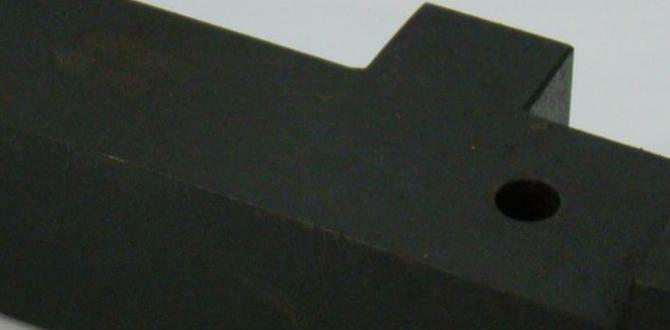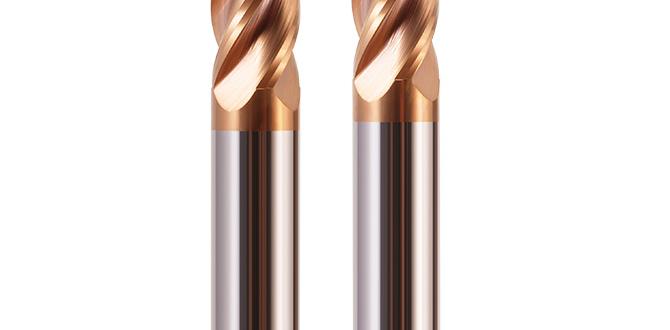A 1/8″ carbide end mill is essential for precise steel cuts, offering durability and accuracy for hobbyists and professionals, making it a go-to tool for detailed milling tasks on mild and tougher steels.
Are you staring at a piece of steel, wondering how to make those intricate cuts and shapes? It can feel a bit daunting, right? Especially when you’re just starting out with milling. You want a tool that’s tough, accurate, and won’t give you a headache. That’s exactly why we’re talking about the 1/8″ carbide end mill for steel today. This little powerhouse might seem small, but it’s been a game-changer for countless machinists. We’ll walk through why it’s so crucial, how to pick the right one, and the best ways to use it safely and effectively. Get ready to boost your confidence and your machining projects!
Why the 1/8″ Carbide End Mill is Your Steel-Cutting Secret Weapon
When it comes to milling steel, especially for detailed work, the 1/8″ carbide end mill isn’t just an option; it’s often the only real choice. Its small diameter allows for incredibly precise cuts, perfect for intricate designs, small features, or even just tight corners. But size isn’t its only advantage.
The Magic of Carbide
Carbide, also known as tungsten carbide, is a super-hard composite material. It’s significantly harder and more rigid than high-speed steel (HSS). What does this mean for you?
Durability: Carbide tools resist wear much better than HSS. This means they stay sharp for longer, even when cutting tough materials like steel.
Heat Resistance: Steel can get hot when milled. Carbide can handle much higher temperatures without softening, allowing you to cut faster and more efficiently.
Precision: Because it’s so rigid, carbide deflects less under load. This translates directly into more accurate cuts and finer details.
Why 1/8″ is Often “Just Right”
The 1/8-inch size is incredibly versatile. It’s small enough for detailed engraving, creating slots, pockets, or chamfers where space is limited. Yet, it’s robust enough for many common machining tasks on mild steel and even some harder alloys. Think of it as the Swiss Army knife of small end mills in your workshop.
Steel Specifics We’re Tackling
We’ll focus on using this end mill with common steels you’ll likely encounter:
Mild Steel: This is your everyday workhorse. It’s relatively soft and easy to machine, making it perfect for beginners.
Heat-Resistant Alloys: These are tougher steels, often used in automotive or aerospace applications. They require specific machining approaches, and a good carbide end mill is key.
Choosing Your 1/8″ Carbide End Mill: What to Look For
Not all 1/8″ carbide end mills are created equal. To get the best results, especially with steel, you need to consider a few key features.
Flute Count: The Backbone of the Cut
End mills come with different numbers of flutes (the cutting edges). For milling steel, here’s a general guideline:
2-Flute End Mill:
Best for: Slotting, pocketing, and general-purpose cutting, especially in materials like aluminum or plastics. When used in steel, they are excellent for plunging (drilling into the material) and clearing chips efficiently due to the larger chip gullets.
Why it matters: The wider spaces between the flutes (chip gullets) allow for better chip evacuation. This is crucial in steel, which can produce long, stringy chips that can jam up the cut and overheat the tool.
3-Flute End Mill:
Best for: General machining of steels and some other materials. Offers a good balance between chip clearance and surface finish.
Why it matters: They provide a smoother surface finish than 2-flute mills because more cutting edges are engaged at any given time. However, chip clearance is slightly more restricted.
4-Flute End Mill:
Best for: Finishing operations, side milling, and achieving very smooth surface finishes in steels. Less ideal for plunging or deep slotting due to limited chip clearance.
Why it matters: With four cutting edges, they provide the best surface finish. They run hotter because chip evacuation is reduced. They are generally not recommended for plunging into steel unless specifically designed for it (e.g., with a center-cutting feature and engineered for high performance).
For general-purpose steel cutting with a 1/8″ end mill, a 2-flute or 3-flute end mill is usually the best starting point for beginners.
Coating: An Extra Layer of Toughness
Coatings are applied to the end mill to enhance its performance. For milling steel, some coatings are particularly beneficial:
TiN (Titanium Nitride): A common, inexpensive coating. It adds hardness and provides some heat resistance, making it suitable for lighter-duty steel machining. It also creates a distinctive gold color.
TiAlN (Titanium Aluminum Nitride): A much more advanced coating that performs exceptionally well on steels, especially at higher temperatures. It forms a protective aluminum oxide layer at high heat, allowing the tool to withstand extreme cutting conditions. It typically has a dark or purplish color.
Uncoated: Sometimes, you’ll find high-quality carbide end mills that are uncoated but made from premium grades of carbide. These can still perform well but might require more careful coolant management.
For steel, especially if you plan on any significant milling, investing in a TiAlN coated or a high-quality uncoated end mill is highly recommended.
End Type: The Business End
The shape of the end of the end mill matters:
Square End: The most common type. It creates flat-bottomed slots and pockets. Essential for general-purpose machining.
Ball End: Has a rounded tip. Used for creating contoured surfaces, fillets, and 3D shapes.
Corner Radius (Chamfer/Fillet): These have a small radius at the corners where the flutes meet the end. This feature adds strength to the cutting edge and helps prevent chipping, especially crucial when milling harder materials or taking heavier cuts. For steel, a small corner radius (e.g., 0.010″ or 0.020″) can significantly extend tool life.
For general steel milling, a square end mill or one with a small corner radius is usually ideal. A ball end mill is for specific 3D contouring.
Shank Type: Grip and Stability
The shank is the part of the end mill that goes into your tool holder or collet.
Straight Shank: The most common. Needs to be held securely by a collet or tool holder.
Railed/Square/Weldon Shank: These have a flat ground into the side or a full flat. This flat provides an extra point of contact for set screws in some tool holders, preventing rotation and slippage. For a small 1/8″ end mill, this is less critical than for larger tools, but a secure grip is always paramount.
For a 1/8″ end mill, a standard straight shank is usually perfectly adequate, provided you use a good quality collet and tighten it properly.
Material Grade and Length
Carbide Grade: Look for micrograin or sub-micrograin carbide. These offer the best balance of hardness and toughness.
Length: Standard length is common. Longer lengths offer more reach but are less rigid. For 1/8″ end mills, standard length is usually fine. Ensure it’s long enough to make your cut without the shank entering the workpiece or debris.
The Essential 1/8″ Carbide End Mill for Steel: Specifications at a Glance
Here’s a table summarizing what to look for:
| Feature | Recommendation for Steel (Beginner) | Why it’s Important |
|---|---|---|
| Flute Count | 2 or 3 Flutes | Balance of chip clearance and surface finish. 2-flute is great for plunging and chip clearing; 3-flute offers a smoother finish. |
| Coating | TiAlN or High-Quality Uncoated | Superior heat resistance and wear resistance needed for steel. TiN is a budget option but less effective. |
| End Type | Square End or Small Corner Radius | Versatile for flat-bottomed cuts and adds edge strength. |
| Shank Type | Straight Shank with Secure Holder | Standard and effective when properly gripped by a collet. |
| Carbide Grade | Micrograin or Sub-micrograin | Offers the best toughness and hardness combination. |
| Standard Length | Standard | Sufficient reach for most small-part applications without sacrificing rigidity. |
Setting Up for Success: Your First Steps with a 1/8″ End Mill
You’ve got your tool, now let’s talk about how to use it safely and effectively in your milling machine.
1. Secure Your Workpiece: The Foundation of Accuracy
This is the absolute most critical step. If your workpiece isn’t held down tightly, it can shift, leading to ruined parts, damaged tools, or worse, serious injury.
Vise: A good milling vise is your best friend. Ensure it’s clean, the jaws are parallel to the table travel, and you’re using appropriate vise stops if needed.
Clamps: For larger or irregularly shaped pieces, use clamp sets. Position them to apply downward force, preventing the workpiece from lifting.
Fixtures: For repetitive tasks, consider creating a custom fixture. This ensures perfect alignment every time.
Always double-check your clamping. A quick wiggle test can save you a lot of trouble.
2. Mount the End Mill Correctly: No Wobble Allowed!
Your end mill needs to be held perfectly true to prevent runout, which causes vibration, poor finish, and tool breakage.
Collets: Use a high-quality collet with a matching decimal size for your 1/8″ (0.125″) shank. A 1/8″ collet is ideal. Too loose, and the tool can slip; too tight, and you risk damaging the collet or the tool shank.
Tool Holder: If you use a tool holder, ensure the collet is seated correctly within it.
Tighten Securely: Tighten the collet nut firmly but don’t overtighten. You want the shank seated, not compressed.
Avoid using drill chucks for end mills. They are not designed for the side loads of milling and will lead to runout and inaccurate cuts.
3. Set Your Zero (Work Offset): The Starting Point
You need to tell the machine where to start cutting.
Edge Finder or Probe: Use an edge finder or a probe to accurately locate the edge of your workpiece or a reference feature.
Tool Height: Ensure the top surface of your workpiece is accurately set relative to your machine’s Z-axis. An indicator on the spindle or a tool setter is perfect for this.
4. Choose Your Cutting Strategy: Less is More for Beginners
When milling steel with small tools, it’s wise to be conservative.
Stepover (X/Y Axis): This is how much the end mill moves sideways on each pass. For finishing, a small stepover (e.g., 10-20% of the tool diameter, so 0.012″ – 0.024″ for 1/8″) gives a better surface. For roughing or pocketing, you might go wider (up to 50% or more if the machine can handle it).
Stepdown (Z Axis): This is how deep the end mill cuts into the material on each pass. For steel with a 1/8″ end mill, start very conservatively. A stepdown of 0.010″ to 0.020″ is a good starting point. Going deeper risks tool breakage. You can always increase it once you’re comfortable and have observed the machine’s performance.
Machining Steel with Your 1/8″ End Mill: The How-To
Now for the actual cutting. This involves understanding speeds, feeds, and chip management.
Speeds and Feeds: The Sweet Spot
This is where most beginners get tripped up. Getting speeds and feeds right is crucial for tool life, finish, and efficiency.
Surface Speed (SFM – Surface Feet per Minute): This is the speed at which the cutting edge moves across the material. For 1/8″ carbide end mills in mild steel, a good starting range is 200-400 SFM.
Spindle Speed (RPM – Revolutions Per Minute): This is what you set on your machine. You calculate it using the formula:
RPM = (SFM 3.82) / Diameter (inches)
Let’s calculate for a common scenario:
Material: Mild Steel
Tool Diameter: 1/8″ (0.125″)
Target SFM: 300 SFM
RPM = (300 3.82) / 0.125 = 9168 RPM
Most hobbyist machines won’t hit 9000 RPM. If your machine has a maximum of, say, 3000 RPM, you’ll need to adjust your SFM down.
Let’s recalculate for 3000 RPM on mild steel with 1/8″ carbide:
SFM = (RPM Diameter) / 3.82
SFM = (3000 0.125) / 3.82 = 98.17 SFM
This is on the lower end for carbide but perfectly acceptable for many machines and materials.
Feed Rate (IPM – Inches Per Minute): This is how fast the cutter moves through the material. For a 1/8″ end mill in mild steel at moderate RPM, a good starting feed rate might be 5-15 IPM.
Key Takeaway: Always start conservatively. Listen to the machine. If it’s screaming, slow down. If it’s chattering, adjust.
Chip Load: The Heart of Cutting
Chip load is the thickness of the chip being removed by each cutting edge of the end mill.
Chip Load Formula:
Chip Load = Feed Rate (IPM) / RPM / Number of Flutes
Let’s plug in some numbers:
Feed Rate: 10 IPM
RPM: 3000
Flutes: 2
Chip Load = 10 / 3000 / 2 = 0.00167 inches per tooth
This is quite a small chip load, which is appropriate for small tools in harder materials. For softer materials or larger tools, you’d aim for bigger chips.
A chip load that’s too small leads to rubbing, heat buildup, and premature tool wear. A chip load that’s too big can chip the cutter or overload the machine.
Coolant and Lubrication: Essential for Steel
Cutting steel generates a lot of heat. Without proper cooling, your carbide end mill will overheat, lose its hardness, and fail quickly.
Flood Coolant: The best option. A pump delivers a continuous flow of cutting fluid directly to the cutting zone.
Mist Coolant: Sprays a fine mist of coolant and air. Good for many operations.
Cutting Fluid/Oil: Apply directly to the cutting edge with a brush or squirt bottle. Choose a fluid specifically designed for machining steel. For mild steel, a general-purpose synthetics or semi-synthetics are good. For tougher alloys, you might need a more specialized lubricant.
Air Blast: Can help clear chips but doesn’t offer significant cooling.
Never try to mill steel dry with a carbide end mill. It’s a recipe for disaster. A good resource for speeds and feeds is the Iscar Tools catalog, which provides extensive recommendations.
Step-by-Step Machining Process for Steel
Let’s assume you want to mill a simple pocket in a block of mild steel.
- Prepare Your Machine: Ensure your milling machine is clean, lubricated, and powered on.
- Secure Workpiece: Clamp your block of mild steel firmly in the vise.
- Insert Tool: Install your 1/8″ carbide end mill (2-flute, TiAlN coated is ideal) into a clean collet, and tighten it securely in the spindle.
- Set Work Coordinate System (WCS): Use an edge finder to locate the X and Y zero on your workpiece. Use a tool setter or indicator to set the Z zero at the top surface of the steel.





